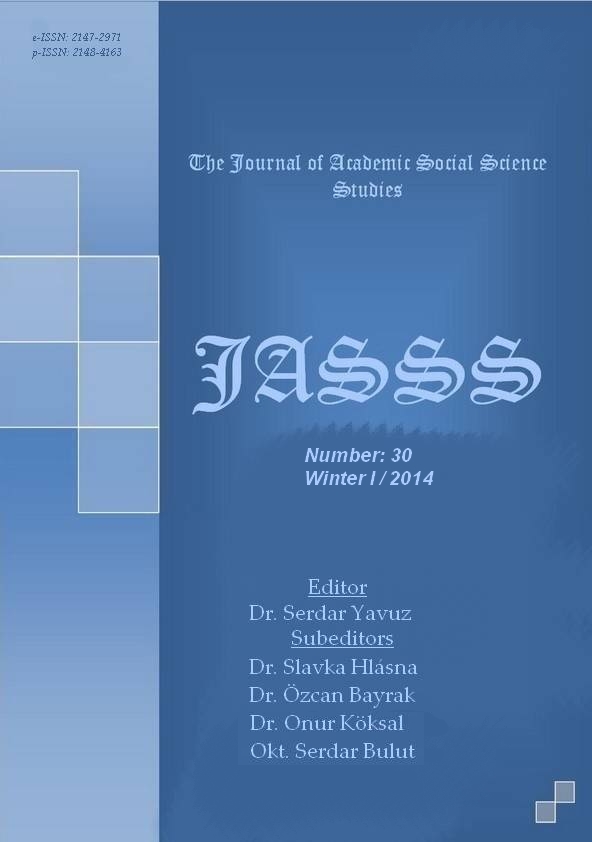Author :
Abstract
Türkçede üçüncü teklik şahıs iyelik eki, şekil ve işlev bakımından iyelik ekleri içinde özel bir yere sahiptir. Birinci ve ikinci şahıs iyelik ekleri, sadece sahip olunan isimlere eklenerek sahip olan şahsı (insanı) gösterirken üçüncü şahıs iyelik eki, bütün varlıklar için kullanılmaktadır. Aklı olan varlıklarda sahiplik bildiren ve diğer varlıklarda parça-bütün ilişkisi, belirlilik gibi görevler üstlenen üçüncü şahıs iyelik ekinin kullanım alanı oldukça geniştir. İsimler üzerinde +(s)I biçimiyle kullanılan iyelik ekinden sonra hâl ekleri getirildiğinde, iki ek arasında /n/ ünsüzü türemektedir. Bu türeme, tarihî Çağatay Türkçesi ve Özbek, Uygur lehçeleri dışındaki hemen bütün Türk lehçe ve ağızlarında görülür. Benzer bir /n/ türemesine zamir çekiminde rastlanır. Genellikle “zamir n’si” olarak değerlendirilen bu ünsüzün iyelik eki ya da zamire ait olup olmadığı tartışma konusudur. Ayrıca yükleme hâlindeki iyelikli isimlerin sonuna eklenen +n ünsüzünün iyelik ekiyle ilişkisi henüz tam olarak açıklanamamıştır. Bu bildiride Türkçede kullanılan üçüncü teklik şahıs iyelik ekinin şekli, kökeni ve işlevleri, karşılaştırmalı olarak yeniden ele alınmıştır. Hâl eki almış ve hâl eki almamış iyelikli isimlerle zamir çekiminde ortaya çıkan /n/ ünsüzünün görevi ve kökeni, iyelik-belirtme, iyelik-yükleme ve iyelik eki-zamir ilişkisi çerçevesinde incelenmiştir. Konuyla ilgili çalışmalarda henüz cevaplandırılmamış sorulara cevap aranmıştır. Böylece Türkçede kullanılan üçüncü teklik şahıs iyelik ekinin şekli, işlevleri ve kökeni ilgili tereddütler giderilmeye çalışılmıştır.
Keywords
Abstract
The third person possessive suffix in terms of form and function has a special place in the possessive suffixes. The first and second person possessive suffixes, only the person who has owned the addition of nouns (person) indicates the third person possessive suffix is used for all assets. The third person possessive suffix, which represents possession for person and undertakes situation part-totality relationship and determinacy etc. on the other assets, usage area is quite extensive. It is used on the nouns as +(s)I, but a consonant /n/ that is come into being in the course of time is employed the person suffix together with case ending have created foundation of disagreement. This epenthesis is seen in all Turcic dialects out of historical Chagatai and Uzbek, Uighur. Disagreement about form and functions of the suffix can not have been becoming yet. Generally denominated “pronominal n” is used between the possessive suffixes and case ending can be directly attached to possessive suffixes in the various Turkic dialects. A consonant /n/ that is come into being in the course of time is employed the person suffix together with case ending have created foundation of disagreement. A consonant e.g. /n/ there is used between the possesive suffixes and case ending can be directly attached to possessive suffixes in the various Turkic dialects. This situation have caused confusion between the possessive suffixes and case ending. The proposal of this study is to solve the problem by examining all over the samples of the possessive and accusative in the historical and contemporary Turkic dialects. It discussed in comparison with form, origin and function of the third person possessive suffix in Turkish.
